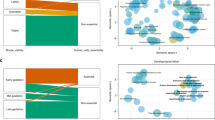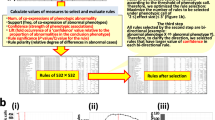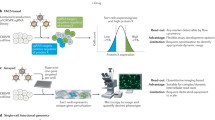Abstract
The function of the majority of genes in the mouse and human genomes remains unknown. The mouse embryonic stem cell knockout resource provides a basis for the characterization of relationships between genes and phenotypes. The EUMODIC consortium developed and validated robust methodologies for the broad-based phenotyping of knockouts through a pipeline comprising 20 disease-oriented platforms. We developed new statistical methods for pipeline design and data analysis aimed at detecting reproducible phenotypes with high power. We acquired phenotype data from 449 mutant alleles, representing 320 unique genes, of which half had no previous functional annotation. We captured data from over 27,000 mice, finding that 83% of the mutant lines are phenodeviant, with 65% demonstrating pleiotropy. Surprisingly, we found significant differences in phenotype annotation according to zygosity. New phenotypes were uncovered for many genes with previously unknown function, providing a powerful basis for hypothesis generation and further investigation in diverse systems.
This is a preview of subscription content, access via your institution
Access options
Subscribe to this journal
Receive 12 print issues and online access
$209.00 per year
only $17.42 per issue
Buy this article
- Purchase on Springer Link
- Instant access to full article PDF
Prices may be subject to local taxes which are calculated during checkout






Similar content being viewed by others
Change history
14 August 2015
In the version of this article initially published online, the authors neglected to acknowledge one of the funding sources for their study. The acknowledgements should have recognized support from the Medical Research Council under project number MC_U142684172. The error has been corrected for the print, PDF and HTML versions of this article.
References
Blake, J.A. et al. The Mouse Genome Database: integration of and access to knowledge about the laboratory mouse. Nucleic Acids Res. 42, D810–D817 (2014).
Brown, S.D., Wurst, W., Kuhn, R. & Hancock, J.M. The functional annotation of mammalian genomes: the challenge of phenotyping. Annu. Rev. Genet. 43, 305–333 (2009).
Brown, S.D., Hancock, J.M. & Gates, H. Understanding mammalian genetic systems: the challenge of phenotyping in the mouse. PLoS Genet. 2, e118 (2006).
Gailus-Durner, V. et al. Introducing the German Mouse Clinic: open access platform for standardized phenotyping. Nat. Methods 2, 403–404 (2005).
Wagner, G.P. & Zhang, J. The pleiotropic structure of the genotype-phenotype map: the evolvability of complex organisms. Nat. Rev. Genet. 12, 204–213 (2011).
Simon, M.M. et al. A comparative phenotypic and genomic analysis of C57BL/6J and C57BL/6N mouse strains. Genome Biol. 14, R82 (2013).
White, J.K. et al. Genome-wide generation and systematic phenotyping of knockout mice reveals new roles for many genes. Cell 154, 452–464 (2013).
Brown, S.D. & Moore, M.W. Towards an encyclopaedia of mammalian gene function: the International Mouse Phenotyping Consortium. Dis. Model. Mech. 5, 289–292 (2012).
Brown, S.D., Chambon, P., de Angelis, M.H. & Eumorphia, C. EMPReSS: standardized phenotype screens for functional annotation of the mouse genome. Nat. Genet. 37, 1155 (2005).
Mallon, A.M., Blake, A. & Hancock, J.M. EuroPhenome and EMPReSS: online mouse phenotyping resource. Nucleic Acids Res. 36, D715–D718 (2008).
Skarnes, W.C. et al. A conditional knockout resource for the genome-wide study of mouse gene function. Nature 474, 337–342 (2011).
Morgan, H. et al. EuroPhenome: a repository for high-throughput mouse phenotyping data. Nucleic Acids Res. 38, D577–D585 (2010).
Koscielny, G. et al. The International Mouse Phenotyping Consortium Web Portal, a unified point of access for knockout mice and related phenotyping data. Nucleic Acids Res. 42, D802–D809 (2014).
Higgins, J.P., Thompson, S.G., Deeks, J.J. & Altman, D.G. Measuring inconsistency in meta-analyses. Br. Med. J. 327, 557–560 (2003).
McKusick, V.A. Mendelian Inheritance in Man and its online version, OMIM. Am. J. Hum. Genet. 80, 588–604 (2007).
Rath, A. et al. Representation of rare diseases in health information systems: the Orphanet approach to serve a wide range of end users. Hum. Mutat. 33, 803–808 (2012).
Bassett, J.H. et al. Rapid-throughput skeletal phenotyping of 100 knockout mice identifies 9 new genes that determine bone strength. PLoS Genet. 8, e1002858 (2012).
Huang, N., Lee, I., Marcotte, E.M. & Hurles, M.E. Characterising and predicting haploinsufficiency in the human genome. PLoS Genet. 6, e1001154 (2010).
Pandey, A.K., Lu, L., Wang, X., Homayouni, R. & Williams, R.W. Functionally enigmatic genes: a case study of the brain ignorome. PLoS ONE 9, e88889 (2014).
Johnson, K.R., Longo-Guess, C.M. & Gagnon, L.H. Mutations of the mouse ELMO domain containing 1 gene (Elmod1) link small GTPase signaling to actin cytoskeleton dynamics in hair cell stereocilia. PLoS ONE 7, e36074 (2012).
Pettitt, S.J. et al. Agouti C57BL/6N embryonic stem cells for mouse genetic resources. Nat. Methods 6, 493–495 (2009).
Karp, N.A. et al. Applying the ARRIVE guidelines to an in vivo database. PLoS Biol. 13, e1002151 (2015).
Hoehndorf, R., Schofield, P.N. & Gkoutos, G.V. PhenomeNET: a whole-phenome approach to disease gene discovery. Nucleic Acids Res. 39, e119 (2011).
Cunningham, F. et al. Ensembl 2015. Nucleic Acids Res. 43, D662–D669 (2015).
Beck, T., Hastings, R.K., Gollapudi, S., Free, R.C. & Brookes, A.J. GWAS Central: a comprehensive resource for the comparison and interrogation of genome-wide association studies. Eur. J. Hum. Genet. 22, 949–952 (2014).
Kitsios, G.D., Tangri, N., Castaldi, P.J. & Ioannidis, J.P. Laboratory mouse models for the human genome-wide associations. PLoS ONE 5, e13782 (2010).
Nelson, S.J. & Schulman, J.L. Orthopaedic literature and MeSH. Clin. Orthop. Relat. Res. 468, 2621–2626 (2010).
Acknowledgements
The EUMODIC project was funded by European Commission contract number LSHG-CT-2006-037188. The work at MRC-Harwell was funded by the Medical Research Council under project MC_U142684172. The work at the Toronto Centre for Phenogenomics (TCP) was funded under the NorCOMM project by the government of Canada through Genome Canada and Genome Prairie. The Institut Clinique de la Souris (ICS) has been supported by French state funds through the Agence Nationale de la Recherche under the framework program Investissements d'Avenir by ANR-10-IDEX-0002-02, ANR-10-LABX-0030-INRT and ANR-10-INBS-07 PHENOMIN. A full list of members of the EUMODIC consortium who contributed to the goals of the project is available in the Supplementary Note, and a list of partners is available at http://www.eumodic.org/partners.html.
Author information
Authors and Affiliations
Consortia
Contributions
M.H.d.A., K.P.S., Y.H. and S.D.M.B. conceived the study and directed the research. G.N., H. Morgan, A.-M.M. and S.D.M.B. wrote the manuscript. M. Selloum, J.K.W., R.R.-S., T. Sorg, S.W., H.F., M.F., D.J.A., N.C.A., T.A., A.A.-P., D.A.-H., G.A., P.A., S.A., A. Auburtin, A. Ayadi, J. Becker, L.B., E.B., R.B., M.-C.B., J. Bottomley, M.R.B., V.B., D.H.B., J.N.B., J.C.-W., H.C., M.-F.C., P.C., C.C., F.C., G.F.C., R. Combe, R. Cox, E.D., A. Dierich, B.D., A. Duchon, O.E., C.T.E., L.E.F., I.E., J.E., J.F., A.F., A. Gambadoro, L. Garrett, H.G., A.-K.G., L. Glasl, P.G., I.G.D.C., A. Götz, J.G., A. Guimond, W.H., G.H., S.M.H., H.H., T.H., R. Houghton, A.H., B.I., H.J., S.J., H.A.K., S.K., T.K.-R., M.K., T.K., V.L., E.l.M., T.L., A.L., C. McKerlie, J.-L.M., S. Marschall, M.M., H. Meziane, K.M., C. Mittelhauser, L.M., D.M., S. Muller, B.N., F.N., P.M.N., L.M.J.N., M.O., G.P., N.S.P., E.P., B.P.-D., A.P., C.P., P.P., L.P., O.P., D.R., S.R., L.Q.-F., M.M.Q., I.R., B.R., F.R., J. Rossant, M.R., J. Rozman, E.R., J.S., K.-H.S., E.S., A.S., H.S., R.S., M. Stewart, C.S., T. Stöger, M. Sun, D.S., L.T., I. Tilly, G.P.T.-V., M.T., I. Treise, E.V., D.V.-W., C.W., B.W., O.W., M.W., E.W., A. Wolter, W.W., A.Ö.Y., R.Z., A. Zimmer, A. Zimprich and V.G.-D. undertook mouse generation, phenotyping, and data acquisition and assessment from the phenotyping pipelines. G.N., H. Morgan, A.B., A.D.F., T.F., G.G., S.G., J.M.H., R. Hoehndorf, N.J., N.A.K., S.L., C.L., H. Maier, D.G.M., L.S., M. Simon, L.V., A. Walling, M.W.-D., H.W., J.W., C.H. and A.-M.M. developed data tools and databases, and carried out data and statistical analyses.
Corresponding author
Ethics declarations
Competing interests
The authors declare no competing financial interests.
Additional information
A list of members and affiliations is provided in the Supplementary Note.
Supplementary information
Supplementary Text and Figures
Supplementary Figures 1–7, Supplementary Tables 1 and 2, and Supplementary Note. (PDF 2819 kb)
Supplementary Data Set
Between-center workflow comparison. (PDF 899 kb)
Rights and permissions
About this article
Cite this article
Hrabě de Angelis, M., Nicholson, G., Selloum, M. et al. Analysis of mammalian gene function through broad-based phenotypic screens across a consortium of mouse clinics. Nat Genet 47, 969–978 (2015). https://doi.org/10.1038/ng.3360
Received:
Accepted:
Published:
Issue Date:
DOI: https://doi.org/10.1038/ng.3360
This article is cited by
-
Defects in placental syncytiotrophoblast cells are a common cause of developmental heart disease
Nature Communications (2023)
-
A consensus score to combine inferences from multiple centres
Mammalian Genome (2023)
-
Pleiotropy data resource as a primer for investigating co-morbidities/multi-morbidities and their role in disease
Mammalian Genome (2022)
-
Extensive identification of genes involved in congenital and structural heart disorders and cardiomyopathy
Nature Cardiovascular Research (2022)
-
Proteotyping of knockout mouse strains reveals sex- and strain-specific signatures in blood plasma
npj Systems Biology and Applications (2021)



